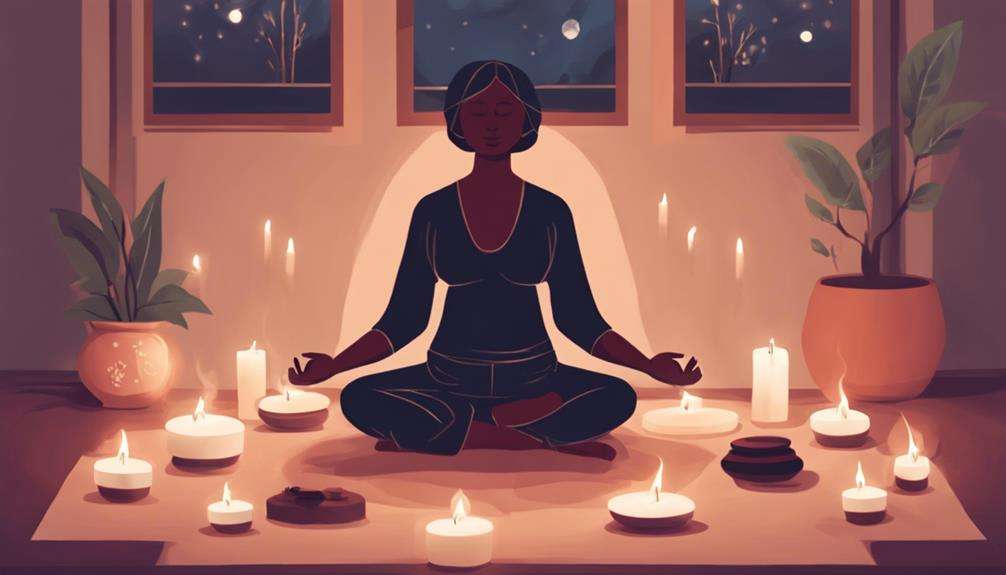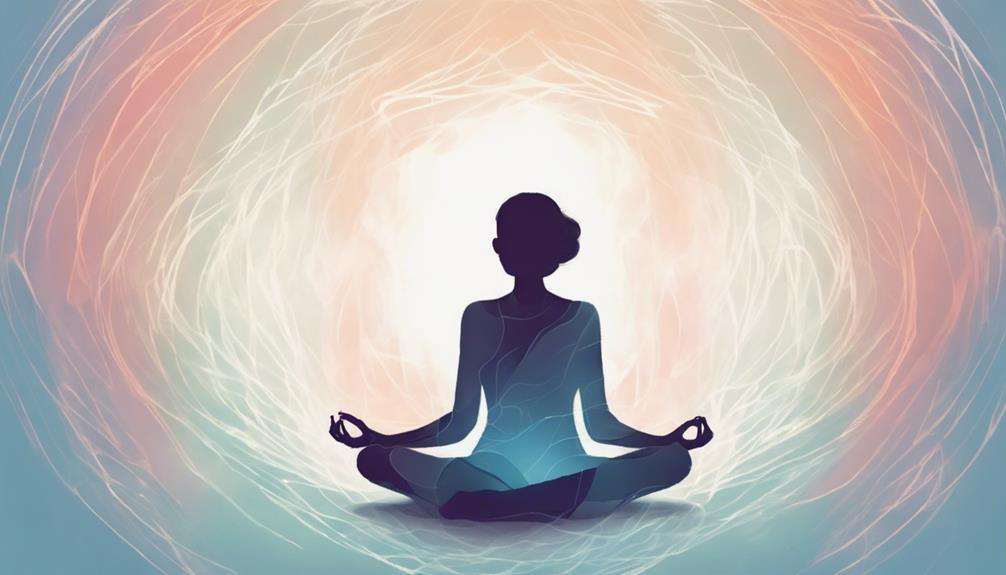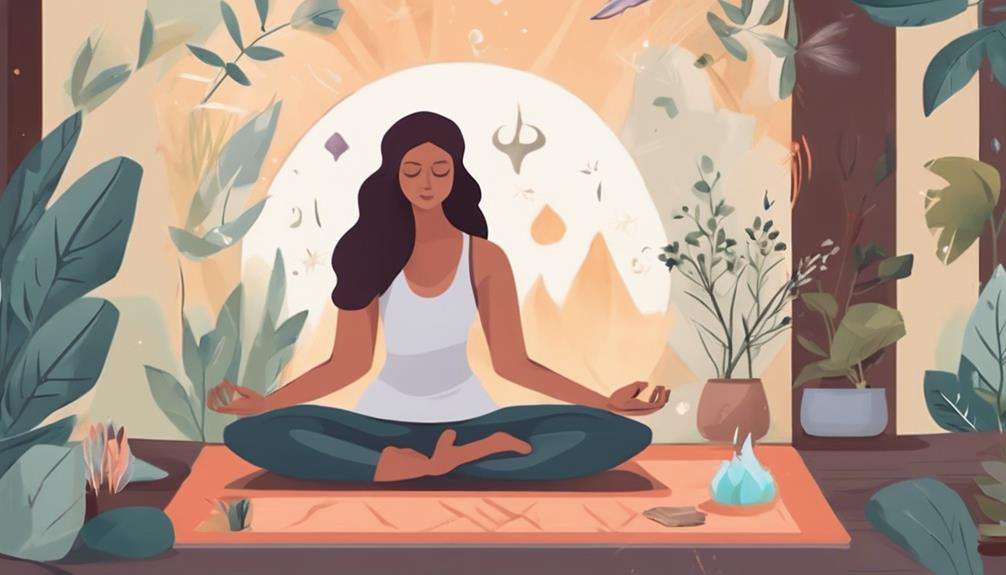Imagine your mind as a garden, where anxious thoughts are like weeds threatening to overtake the blossoming flowers of peace.
As you seek ways to tend to this garden of your mind, exploring which mindfulness practices effectively reduce anxiety becomes essential.
By understanding how techniques like breathwork, body scans, and non-reactivity can act as tools to nurture your mental landscape, you may discover a path towards tranquility amidst life's storms.
Key Takeaways
- Breathwork techniques like diaphragmatic breathing and box breathing effectively reduce anxiety symptoms.
- Body-centered mindfulness practices, such as body scans, release tension and promote relaxation for anxiety relief.
- Non-reactivity mindfulness approaches help in observing anxious thoughts without immediate reactions, reducing anxiety triggers.
- Mindfulness meditation techniques foster present-moment awareness, calm observation of thoughts, and reduce impulsive reactions to alleviate anxiety.
Breathwork Techniques for Anxiety
To effectively manage and reduce anxiety, implementing breathwork techniques can provide significant relief and relaxation. Breath awareness is key to these practices, allowing you to focus on the present moment and calm the mind. Diaphragmatic breathing, which involves deep breaths that expand the belly, activates the body's relaxation response, helping to alleviate anxiety symptoms.
Box breathing, a technique where you inhale, hold, exhale, and hold your breath for equal counts, aids in managing anxiety by regulating your breathing pattern. Alternate nostril breathing is another effective method that balances the brain hemispheres, promoting calmness and reducing anxiety levels. The 4-7-8 breathing technique, with its specific inhale-hold-exhale pattern, calms the nervous system and helps in alleviating anxiety effectively.
Engaging in breath counting practice can enhance concentration by focusing your mind on the breath, diverting attention from anxious thoughts and promoting a sense of calm. These breathwork techniques not only help in reducing anxiety but also contribute to overall well-being by positively impacting your nervous system and concentration levels.
Mindful Body Scan Practice
Implementing mindful body scan practice involves systematically focusing on each part of your body to increase awareness and reduce anxiety. By engaging in this practice, you can effectively reduce stress and promote relaxation by recognizing tension, stress, or discomfort in different areas of your body. Tuning into physical sensations during a body scan session helps ground you in the present moment, fostering a sense of presence and calm. This heightened awareness allows you to identify specific areas holding tension due to anxiety, enabling you to apply targeted relaxation techniques for relief.
Regular practice of mindful body scanning not only enhances your overall body awareness but also cultivates relaxation responses that are crucial for managing anxiety. Through this practice, you can develop a deeper connection with your body, learn to release tension, and promote a state of relaxation that supports anxiety management. Embrace the mindful body scan practice as a valuable tool in your journey towards reducing anxiety and fostering greater well-being.
Grounding Exercises for Anxiety Relief
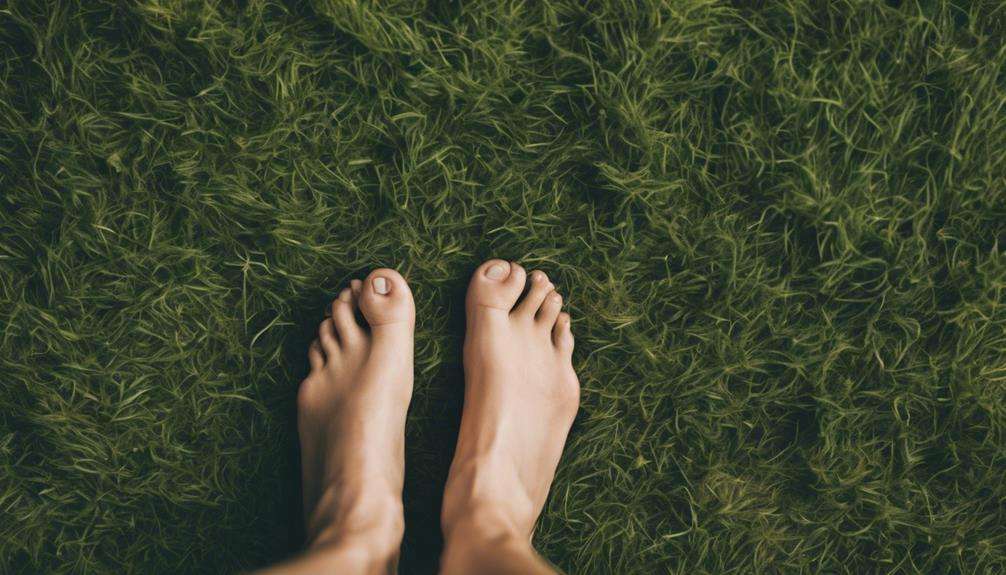
Grounding exercises for anxiety relief involve practical techniques that help individuals maintain presence and focus during moments of distress. These exercises are designed to help you detach from anxiety and concentrate on what you can control. By incorporating grounding exercises into your routine, you can experience a sense of stability and calmness even when facing challenges that trigger anxiety. Some common grounding techniques include:
- Square breathing: Inhale for four counts, hold for four, exhale for four, and then hold for four again.
- Breath awareness: Focus on your breath, noticing the sensation as you inhale and exhale.
- Body scan: Slowly bring awareness to each part of your body, releasing tension as you go.
- Grounding objects: Hold onto an object and focus on its texture and weight to anchor yourself in the present moment.
Regular practice of grounding exercises can empower you to manage anxiety effectively, ultimately enhancing your overall well-being.
Cultivating Non-Reactivity Mindfulness
Incorporating non-reactivity mindfulness into your daily routine can enhance your ability to navigate anxious thoughts with a sense of calmness and clarity.
By practicing non-reactivity mindfulness, you learn to observe anxious thoughts without immediately reacting to them. This practice helps in creating space between the triggers of anxiety and your responses, allowing for a more objective and measured reaction to these thoughts.
Cultivating non-reactivity enables you to reduce the power that anxious thoughts hold over you by not engaging with them impulsively. Through the development of non-reactivity, you can observe your thoughts without getting caught up in them, ultimately leading to a decrease in anxiety levels.
Embracing this approach fosters a mindset that's more attuned to observing thoughts without being overwhelmed by them, contributing to a greater sense of peace and reduced anxiety in your daily life.
Noting Practice for Anxiety
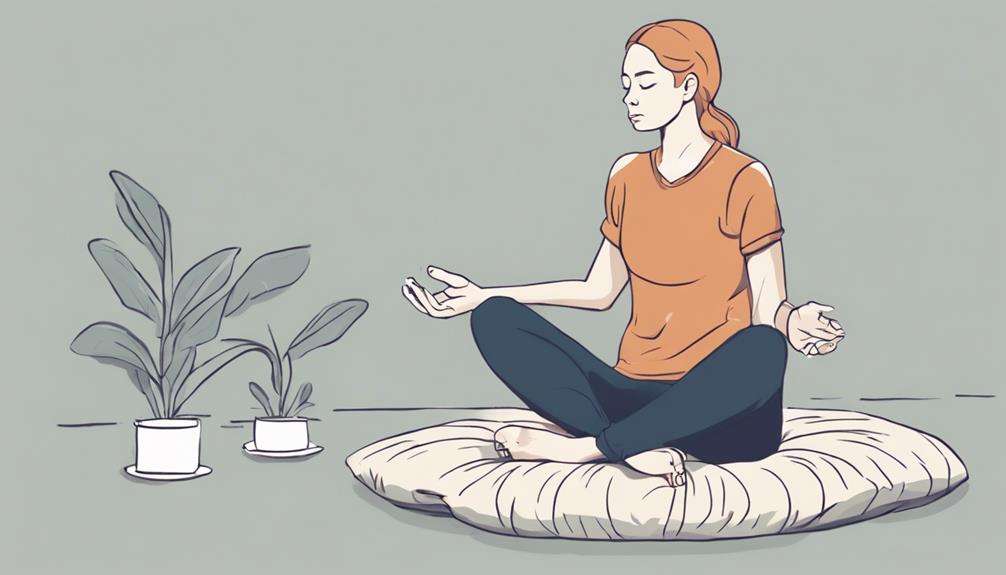
Developing the practice of noting anxious thoughts objectively can significantly enhance your ability to manage anxiety with a sense of calm and clarity. Noting practice involves observing anxious thoughts as they arise, strengthening non-reactivity by creating space for thoughts without getting entangled in them. This interruption in the anxiety cycle allows for a calmer response to emotions, aiding in developing a new perspective on anxious thoughts without judgment. By noting thoughts as they come and go, individuals can gradually reduce the power that anxious thoughts hold over them.
- Observing anxious thoughts objectively
- Strengthening non-reactivity
- Creating space for thoughts
- Developing a new perspective without judgment
Mindful Pausing Techniques
When facing moments of heightened anxiety, incorporating mindful pausing techniques can be a beneficial strategy.
Taking a few intentional breaths and practicing a body scan relaxation technique can help you center yourself and ease tension.
Grounding mindfulness practices can assist you in reconnecting with the present moment and reducing the impact of anxious thoughts.
Breathing Exercises for Calmness
Engaging in mindful breathing techniques cultivates a sense of calmness and relaxation by harnessing the power of your breath.
Mindful breathing, such as diaphragmatic breathing, activates the parasympathetic nervous system, aiding in relaxation and reducing anxiety.
Deep breathing methods help calm the body's stress response, lowering cortisol levels for a more peaceful state of mind.
Controlled breathing practices, like box breathing, regulate emotions, bringing a profound sense of calmness during moments of anxiety.
Body Scan Relaxation Technique
To deepen your mindfulness practice and further reduce anxiety, consider incorporating the Body Scan relaxation technique into your daily routine.
The Body Scan method involves systematically focusing on different parts of your body, increasing awareness of physical sensations and promoting mindfulness in the present moment. By tuning into these sensations without judgment, you can calm your mind and alleviate symptoms of anxiety.
Research indicates that regular practice of the Body Scan technique is effective in reducing stress, anxiety, and enhancing overall well-being. This practice can also strengthen the mind-body connection, fostering relaxation, and improving your mental health.
Embrace this simple yet powerful relaxation technique to nurture your well-being and cultivate a greater sense of inner peace.
Grounding Mindfulness Practice
Implementing grounding mindfulness practices, particularly mindful pausing techniques, can significantly enhance your ability to manage anxiety triggers effectively. Grounding mindfulness practice involves pausing before reacting to anxious situations, allowing for a calmer response.
By observing thoughts and emotions without judgment during a mindful pause, you can interrupt the anxiety cycle effectively. Bringing awareness back to the breath after pausing helps in staying present and reducing anxiety symptoms.
Creating space by taking deep breaths during a mindful pause can shift the focus away from anxious thoughts. Noting anxious thoughts objectively during a pause helps in strengthening non-reactivity and reducing the power of anxiety.
Mindfulness Meditation for Anxiety
Mindfulness meditation offers a powerful tool for managing anxiety by cultivating present-moment awareness and reducing stress levels. This practice involves focusing on the present moment without judgment, allowing individuals to observe their thoughts and emotions, including anxiety triggers, from a place of calmness.
Research indicates that mindfulness meditation can effectively decrease symptoms of anxiety and stress. By regularly engaging in mindfulness practices, individuals can develop the ability to observe anxious thoughts without reacting impulsively, leading to a more composed and measured response to challenging situations. This technique promotes relaxation and a sense of tranquility, counteracting the physiological and psychological symptoms of anxiety.
Mindful Walking for Anxiety Reduction

Transitioning from mindfulness meditation, another effective practice for reducing anxiety is mindful walking, which involves focusing on the sensations of walking to promote relaxation and grounding in the present moment. Mindful walking can help reduce anxiety by allowing you to immerse yourself in the experience of each step, bringing your attention to the present moment and away from anxious thoughts.
Here are some key points to consider when practicing mindful walking:
- Pay attention to the sensations of walking, such as the pressure on your feet and the movement of your body.
- Take your mindful walking outdoors to benefit from nature's calming effects and enhance the relaxation experience.
- Walk at a slow pace to fully engage with each step and promote a sense of tranquility.
- Integrate mindful walking into your daily routines to cultivate mindfulness in movement and provide a gentle way to alleviate anxiety.
Intention Setting Practices for Anxiety
To effectively reduce anxiety, incorporating intention setting practices is key for guiding your mindfulness journey towards a more purposeful and focused approach.
Setting clear, positive goals through intention setting can significantly aid in anxiety reduction by directing your attention, fostering awareness, and instilling a sense of purpose in managing anxious feelings.
These intentions can be tailored to address specific anxiety triggers, such as remaining present or practicing self-compassion during moments of distress.
Frequently Asked Questions
How Can I Practice Mindfulness and Reduce Anxiety?
You can practice mindfulness and reduce anxiety by incorporating breathing exercises, body scans, meditation techniques, grounding practices, mindful movement, journaling, gratitude, visualization, nature immersion, and progressive relaxation. These tools help in managing anxiety effectively.
What Is the 3 3 3 Rule Anxiety?
Feeling overwhelmed by anxiety? Try the 3 3 3 rule. Name three things you see, hear, and feel around you. This grounding technique shifts focus, promotes mindfulness, and helps calm your mind quickly.
Can Mindfulness Cure Severe Anxiety?
Mindfulness can't cure severe anxiety entirely, but it offers valuable tools to manage it effectively. Breathing exercises, meditation, grounding activities, and self-compassion practices can help you develop a new relationship with anxiety, fostering acceptance and reducing reactivity.
What Is the Best Therapy for Anxiety?
When dealing with anxiety, the best therapy involves a blend of mindfulness practices like meditation, breathing exercises, yoga poses, grounding techniques, and self-care routines. These techniques help you manage anxiety effectively and promote overall well-being.
Conclusion
In conclusion, incorporating mindfulness practices such as breathwork, body scans, and non-reactivity techniques can effectively reduce anxiety and promote a sense of calm and well-being.
By pausing to connect with the present moment and observing thoughts without judgment, individuals can better manage anxiety triggers and emotional responses.
So, why not give these mindfulness practices a try and experience the benefits for yourself?

